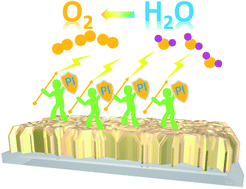Boosting the stability and photoelectrochemical activity of a BiVO4 photoanode through a bifunctional polymer coating†
Abstract
Low stability of photoanodes in electrolytes, especially in alkaline electrolytes, greatly limits their practical applications. Therefore, it is highly meaningful to develop a strategy to stabilize photoanodes under strongly alkaline conditions. Herein, a metal-free poly(p-phenylene pyromellitimide) film is coated onto a BiVO4 photoanode as a bifunctional catalyst layer and protective layer by in situ thermal polymerization. Structural characterization shows that the polymer film can effectively protect the BiVO4 semiconductor. Photoelectrochemical studies verify that the polymer film can improve the efficiency of the surface-reaching hole reaction and promote the separation of surface carriers. Thus, the polymer-coated photoanode shows a superior photoelectrochemical activity, which is 2.5 times higher than that of the pristine photoanode. Meanwhile, the polymer-coated photoanode also exhibits excellent stability in neutral and alkaline electrolytes. The photocurrent remains above 70% even after a six-hour reaction in a strongly alkaline electrolyte. This work provides a simple solution to stabilize semiconductor photoanodes under alkaline conditions for efficient photoelectrochemical applications.

- This article is part of the themed collection: Journal of Materials Chemistry A Lunar New Year collection 2022


 Please wait while we load your content...
Please wait while we load your content...